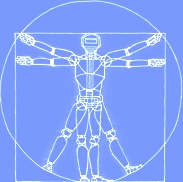
Latent Precursors of Human Intelligence in Brain Mechanisms Subserving Monkey Tool Use
Atsushi Iriki, Riken Brain Science InstituteBimodal neurons in the monkey intraparietal cortex, integrating visual and somatosensory informations, code the image of the self-body, which is subject to intentional modification. When trained to use a tool, it becomes an extension of the hand both physically and perceptually, resulting in alteration of the body image in accordance with the characteristics of the tool at hand. In above bimodal neurons, use-dependent expansion of the receptive field occurred only when the monkeys held a tool and intended to use it as an extension of their hand. This would constitute the neural correlate for modification of the body schema as a basis of assimilation of the tool into our own body. PET imaging studies confirmed that this cortical area is active when monkeys using the rake. Also, we found that these neurons can code the body-image projected onto the video monitor, perhaps corresponding to its iconic representation. During the course of above training, behavioral analyses suggested that a novel mode of somatosensory-visual integration seemed to develop in order to organize adequate bodily movement to manipulate the tool, possibly subserved by reformation of the neural circuitry in which molecular genetic processes in the cortical area described above are involved. Indeed, augmented expression of messenger RNA of neurotrophic factors associated with learning was induced in the corresponding cortical region only during the training to use the tool, but not after monkeys acquired the skill. Corresponding to this period, emergence of novel cortico-cortical projections between temporo-parietal junction and the intra-parietal cortex were detected in monkeys that were trained to use tools, therefore, enabling to integrate the tool in their own body image by presence of a self-objectification mechanism. When above described representations were further advanced, it would become totally free from physical constraints of the actual world to become a symbolic one to represent evolutionary precursors of higher cognitive functions, and might eventually lead to evolution of human language or to the metaphysical thoughts.
Biography:
We are trying to uncover evolutionary precursors of human higher cognitive functions grounded onto physical morphologies and patterns of structured bodily actions, based on behavioral and neurophysiological analyses on chronic macaque monkeys, which were trained to use tools and other high-tech apparatus. By sharing above machineries among individuals, we extrapolate these mechanisms to constitute bases of communicatory functions, and eventually understand neural mechanism of social behaviours. Further, we are aiming at extending these mechanisms onto evolutionary as well as developmental clues of symbolic cognitive functions to subserve inference, metaphysical thoughts, etc. that characterise human intelligence.
See also http://www.brain.riken.go.jp/en/a_iriki.html
